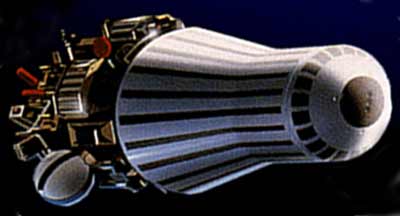Thank you very much for visiting Gunter's Space Page. I hope that this site is useful and informative for you.
If you appreciate the information provided on this site, please consider supporting my work by making a simple and secure donation via PayPal. Please help to run the website and keep everything free of charge. Thank you very much.
EXPRESS

EXPRESS [DARA]
EXPRESS (Experiment Re-entry Space System) was a multi-national (Germany, Japan, Russia, Australia) project for a small, micro gravity and reentry research spacecraft. The spacecraft was procured from Khrunichev for a cost of 30 Mio. DM.
The payload used a Russian-built reentry vehicle, based on an ICBM reentry vehicle, a Russian built service module, derived from the OGCh (FOBS) fractional orbital bombing system, and the launch was carried out by the Japanese ISAS space agency on a M-3S-2 with KM-M kick motor.
The reentry vehicle carried two CATEX materials processing ovens, and three German (CETEX, PYREX and RAFLEX) and one Japanese (RTEX) heat shield material reentry experiments.
- CATEX (Crystalgrowth of catalyst for refining petroleum), NEDO/USEF, Japan
- HIPMEX (High performance material experiment), NEDO/RIMCOF, Japan
- RTEX (Re-entry Experiment), ISAS, Japan
- CETEX (Ceramic tile experiment), Germany
- PYREX (Pyrometric re-entry experiment), Germany
- RAFLEX (Rarefied flux experiment), Germany
It was due to land in the Australian desert after a five day flight, but the thrust vector control on the second stage malfunctioned 103 seconds after launch, and the fourth stage and payload entered a 110 km × 250 km × 33 deg orbit, instead of the intended 270 km × 380 km one. This failure was probably due to second-stage attitude-control oscillations that exhausted attitude-control fuel, probably caused by the heavy payload.
EXPRESS was thought to be lost after launch and was not tracked. But it had indeed reached orbit and reentered the atmosphere during its third orbit. The reentry capsule reentered without guidance in Ghana, where it was discovered 10 months later and retrieved.
| Nation: | Germany, Japan |
|---|---|
| Type / Application: | Micro gravity and return |
| Operator: | DARA, ISAS |
| Contractors: | Khrunichev |
| Equipment: | 2 CATEX, CETEX, PYREX, RAFLEX, RTEX |
| Configuration: | |
| Propulsion: | ? |
| Power: | Batteries |
| Lifetime: | 5 days (planned) |
| Mass: | 765 kg (total); 400 kg recovery capsule, 365 kg service module |
| Orbit: | 110 km × 250 km, 33° (achieved); 270 km × 380 km, 33° (planned) |
| Satellite | COSPAR | Date | LS | Launch Vehicle | Remarks | |
|---|---|---|---|---|---|---|
| EXPRESS | 1995-U01 | 15.01.1995 | Ka LP-M | p | M-3S-2 [KM-M] |
References:
- JAXA / ISAS: EXPRESS
